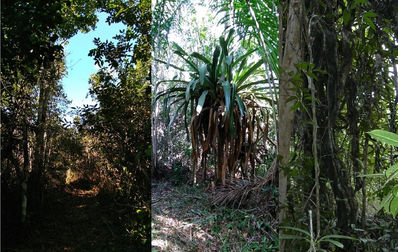PHOTOS
Here are some property photos and a map of each one, identified by its number, at the bottom of the page.
(Clicking on the photos will open them in a larger format in a new window)

View over the coastal plain, coconut groves and sea from Tropicália Farm. On the left, the Guaiú lighthouse.
Photos 01 and 02
A mangaba tree (Hancornia speciosa) on the left (photo 01), a small tree, reaching 3 to 4 meters in height, which grow spontaneously in the region and on the property. An expressive planting of this fruit is foreseen in the property, within an agroforestry system to enrich the most open forest.
The fruits (photo 02) are the size of a plum. The bark is very thin, edible, and exudes a latex with medicinal properties. There is a strong demand for juices and ice cream.
Photo 07
The vegetation thickens and diversifies closer to the water. Currently, the water is no longer perennial, and the stream dries up during the most intense drought periods. Therefore, we are providing wells for supply. Water is easily accessible through wells with no nearby sources of pollution.
Photo 08
We are now on the far west of the property, bordering another neighbor, one of the few places on the property whose boundary is not a road.
The vegetation in this area is also a dense and abundant riparian forest. Leaving the streambed, the relief is quite steep.
Large trees are found on this part of the property.
Photo 09
Piassaba trees (Attalea funifera) are a typical and spontaneous palm tree from the southern region of Bahia. At Tropicália Farm, are harvested from year to year, usually in winter. These are the ones in front of the funnel-shaped mud house.
Brooms and brushes of all kinds are made with the very resistant piassaba fiber, even for industrial machines. It is also a privileged plant to insert in agroforestry systems.
Photo 10
Electricity has also arrived alongside the piassaba trees and the small house, as well as an artesian well which has been drilled very recently.
This place is the future headquarters of Tropicália Farm and the central point of the Ecovilla, easily accessed by road and with access to the telephone network and the Internet.
Vegetable cultivation development is projected near this area. New constructions are predicted for 2021.









